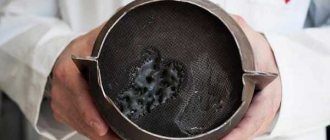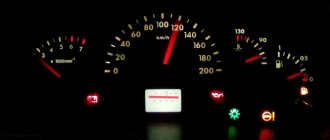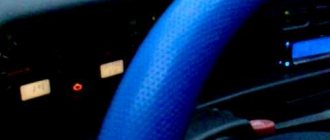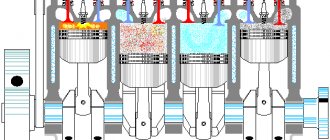What does P0301 mean?
In most cars the engine has 4-6 cylinders. A spark plug fires sequentially in each cylinder, igniting the fuel mixture. Energy is then released from the fuel to drive the crankshaft, which must rotate smoothly as the vehicle moves.
All cylinders work together to ensure continuous rotation of the crankshaft. If a cylinder misfires, it will cause the crankshaft speed (RPM) to increase or decrease.
If the crankshaft speed increases or decreases by 2 percent or more, P0301 will remain in the PCM (automatic transmission control module) memory.
If the RPM increases or decreases by 2 to 10 percent, the Check Engine Light will illuminate on your vehicle's dashboard. If the deviation percentage exceeds 10 percent, the Check Engine light will flash, indicating a more serious problem is present.
Trouble code P0301 indicates that cylinder 1 is misfiring.
RIDE IN TEST MODE
- Connect the handheld diagnostic tool to the DLC3.
- Turn the ignition switch to ON (IG) and turn on the handheld scan tool.
- Record the DTC and freeze data.
- Switch the ECM from normal diagnostic mode to active diagnostic mode using a handheld scan tool.
- Count the number of misfires for each cylinder (CYL ##1-4) while the engine is idling. If the number of misfires is displayed for at least one cylinder, skip the next test drive.
- Drive the vehicle several times at engine speed and engine load equal to the values for MISFIRE RPM and MISFIRE LOAD in DATA LIST mode. HINT: To store misfire related DTCs, the vehicle must be driven for the amount of time specified in the table below and the MISFIRE RPM and MISFIRE LOAD values are maintained in DATA LIST mode.
Engine speed Duration Idling 3 minutes 30 seconds or more 1000 3 minutes or more 2000 1 minute 30 seconds or more 3000 1 minute or more - Check for misfire by reading DTCs and freeze data. HINT: Do not turn the ignition switch off without recording the stored DTCs and freeze data. When the ECM switches to normal diagnostic mode (default), all stored DTCs and freeze data are cleared.
- Record the DTC, freeze data, and number of misfires.
- Turn off the ignition and wait at least 5 seconds.
Causes of error P0301
- Worn or damaged cylinder 1 spark plug
- Lack of compression in cylinder 1
- Worn or damaged spark plug wires and/or ignition coils
- Damage to the distributor cap (if equipped)
- Worn or damaged ignition distributor runner (if equipped)
- Fuel injector damage
- Clogged pipes or valve of the exhaust gas recirculation system
- Valves burning
- Incorrect ignition timing setting
- Vacuum leak
- Low level or low fuel pressure
- Damage to the cylinder head gasket
- Distributor cap wear
- Camshaft position sensor malfunction
- Malfunction of the crankshaft position sensor
- Air flow sensor malfunction
- Oxygen sensor malfunction
- Throttle Position Sensor Malfunction
- Malfunction of the catalytic converter
- PCM malfunction
No matter what car you have, the reasons may be the same.
The scanner or on-board computer generated the error “multiple misfires” and the “check engine” light is on. At the same time, the motor shakes all over and works unstably and intermittently. Of course, continuing to move (if an error occurs along the way) is highly not recommended.
And even if you reset the error with a scanner or by removing the terminal from the battery, the check lamp will stop lighting for a while, but the instability of operation will remain. There may be several options here, so it’s not at all necessary to immediately get into the ignition system.
So let's take a closer look at what could have happened.
Before we figure out what the problem is, it is advisable for us to know how such an error occurs in the memory of the control unit. It is detected by a knock sensor, which compares the engine knock readings with the readings of the rough road sensor. The control unit “knows” at what moment and in which cylinder the process of ignition of the working mixture occurs.
Therefore, he can determine with 100% probability a misfire in a specific cylinder. If there is no indication of any one cylinder, namely multiple misfires, then it is quite possible that the mechanical part of the engine is to blame.
Yes, yes...mechanics can be the cause of such a fault code. And it would be more correct to say “multiple misfires.” That is, it is not correct to blame the ignition system for everything.
The valves may simply be to blame (burnt out or pinched, incorrectly adjusted). But the simplest reason is, of course, the spark plugs, unscrew the spark plugs and check on the bench. If there is no stand, then at least visually inspect for the presence of a breakdown. It is certainly rare for several candles not to work at once, but not an exception. Moreover, knowing the quality of this product. If the spark plugs are turned out, immediately check the compression in all cylinders. It is advisable that the spread does not exceed +-1bar. If in any cylinder the compression differs by more than 2, then pour 10 grams of engine oil into this cylinder and measure the compression again. If it rises to the level of the other cylinders, the cause is the oil scraper rings. If it has increased slightly, then it is still the valve.
Another “banal” reason for such an error is high-voltage wires. Which is also unlikely for several wires to fail at once. But I met this on a Nexia and an old six, because of the wires it completely stalled while driving. You can check the wires with a simple tester by measuring their resistance. Typically it should be within a few kOhms. It varies on different cars.
On old Nexias, high-voltage wires are located directly above the hot exhaust manifold. Therefore, even despite the metal protection, they constantly dry out.
How does a mechanic diagnose a P0301 code?
When diagnosing this error code, a mechanic will do the following:
- Reads all data and error codes stored in the PCM memory using an OBD-II scanner
- Clear error codes from the PCM memory and test drive the vehicle to see if P0301 appears again
- Check the cylinder 1 spark plug wire for wear and damage.
- Check the cylinder 1 spark plug for wear and damage.
- Check the ignition coil for wear and damage
- Check the ignition coil wire for wear and damage.
- If necessary, replace spark plugs, ignition coils, and related wires
- If P0301 appears again after replacing the above components, check the fuel injector and related wires for damage.
- Check the ignition distributor cap and slider (if equipped) for corrosion and damage
- If there are other error codes stored in PCM memory along with P0301, it will clear all present errors.
- Test drive the vehicle to see if P0301 appears again
- If P0301 appears again, check compression in cylinder 1
- If P0301 persists, the problem may be a faulty PCM. In this case, the module may need to be replaced or reprogrammed.
Common errors when diagnosing code P0301
The most common mistake when diagnosing a P0301 code is to replace the spark plugs, ignition coils, and related wires when the problem is damaged fuel injector wires.
Another mistake is to rule out the possibility of failure of the fuel injector itself, the cylinder or the PCM.
Also, mechanics often don't look at other error codes that appear along with the P0301 code. If you do not resolve all present errors, this may cause the P0301 code to appear again.
Subaru - Misfire Detected
The cars that came to us already )) had new spark plugs, coils and washed injectors. And in theory this is correct, repairs begin with this.
We, in turn, began the repair by checking the power and pulses on the coils and injectors.
And we ended up repairing the engine ECU, in each case, because the wires and connectors were intact.
Apparently a typical, but completely curable malfunction. Moreover, cars with 6-cylinder engines suffer from it:
EZ30D
- 2000–2004 Subaru Outback H6 2000–2002 Subaru Legacy GT30 2000–2002 Subaru Legacy Lancaster 6
EZ30R
- 2003–2009 Subaru Legacy 3.0R 2005–2009 Subaru Outback 3.0R 2006–2007 Tribeca
EZ36D
- 2010-current Subaru Legacy 2010-current Subaru Outback 2008-2014 Subaru Tribeca
What repairs can fix the P0301 code?
- Replacing damaged spark plugs
- Replacing worn or damaged spark plug wires and/or ignition coils
- Repair or replace clogged EGR pipes and/or valve
- Replacing burnt valves
- Repairing Vacuum Leaks
- Repairing or replacing a damaged cylinder head gasket
- Replacing a faulty camshaft position sensor
- Replacing a faulty crankshaft position sensor
- Replacing a faulty air flow sensor
- Replacing a faulty oxygen sensor
- Replacing a faulty throttle position sensor
- Replacing a faulty fuel injector
- Replacing a faulty catalytic converter
- Elimination of all present errors
- Replacing the ignition distributor cap and slider (if equipped), as well as wires, spark plugs and ignition coils
- If necessary, repair faulty internal engine components
- Engine replacement (if cylinder is damaged)
- In rare cases, replacing or reprogramming the PCM
Additional comments for troubleshooting P0301
To quickly determine whether the problem is a faulty ignition wire or coil, you must move the wire and/or ignition coil to a different cylinder. If the error code appears again, it is a sign that a worn or damaged ignition wire and/or coil is causing the cylinder to misfire.
When eliminating a misfire error, it is necessary to replace all spark plugs. If you replace the spark plug only in the cylinder that is misfiring, it may cause other cylinders to misfire. It is also very important to eliminate any errors present.
It is imperative to make sure that the spark plug has the correct gap using a gap gauge. If the spark plug is not properly gapped, it can cause the cylinder to misfire. Typically, car manufacturers provide spark plug specifications. These characteristics can be found on a label under the hood of the car or obtained from any auto parts store for your car.
Signs of misfire
There are several different symptoms that you may experience when it comes to engine misfire. Here are some of the most common ones.
Uneven acceleration
When a misfire occurs, you may feel it as a slight or strong jolt coming from the engine. These misfires often occur while the engine is running under load and you are accelerating at high RPMs and high gears. Acceleration problems are a common sign that your engine is misfiring.
Unstable idle
Sometimes there will be passes at idle. The engine sensors receive incorrect readings and the air/fuel mixture becomes incorrect. This can result in a very rough idle. The revolutions can jump up and down, until the engine stops.
see also
Comments 72
The best water displacer is a couple of liters of alcohol per full tank. and cleaning the injectors doesn't take long. There may be wear on the seat and needle. They write to rub it in with some kind of paste, but it makes no sense. the most reliable thing is to replace it with new ones
The injectors drove less than 10 because it’s strange but in + weather it doesn’t bother
I changed the entire exhaust, there was always an error in the oxygen sensor, I had to flash it. And I couldn’t drive at the “factory” anymore. The factory firmware severely “chokes” the engine.
And also, regarding the injectors, when my engine was running rough, the error was due to misfires in the 2nd cylinder. I removed the fuel rail along with the injectors. I turned on the ignition and the second injector began to sweat. I noticed this a long time ago, then I fixed it and forgot about this problem.
I had the same problem as you. One to one. I suffered for a long time, changed everything, cleaned it, but in the end it always crashes in the morning. The problem was solved very simply by updating the firmware. My brain is Bosch 797+, I uploaded the firmware from Icebreaker B11KSS (LR) v7.4. I forgot about this problem.
How did you come to this conclusion about the firmware? I haven’t had my original one for 2 years now.
I mean, how did you come? I asked for it and it arrived) There are different firmwares. I tried many different firmwares, but it stopped crashing on this firmware from Icebreaker.
Personally, for now I’ll dig in the direction of the valve or injector, but what prompted you to sew?
it's an electrical issue, you have a constant voltage on the coil on cylinder 2, that's why it's bad, I had the same thing, only 3 cylinders, in the end I changed the brains, everything became normal
Priora 126 engine 16kl. Misfire 2 cylinders. While driving, mostly on the highway, the check light comes on and there is no ignition in cylinder 2. I reset the error through elm 327 and it works. I also noticed that when the gas pedal is in the floor before the engine starts to slow down a little, then it’s normal. where to dig? To begin with, I want to change the candles. Misfire in cylinder 2 of Priora.
Similar articles
40 comments on “Misfire in cylinder 2 of Priora. Misfire cylinder 2"
On my 12k engine it was 124, so the diagnostics showed cylinder 1, changed the ignition coil, everything was fine.
Ignition coil, change it
You just have a mysterious breakdown... What is the problem with changing the spark plug in the second cylinder and if that doesn’t help, changing the coil? Of course, there is also an injector as an option











